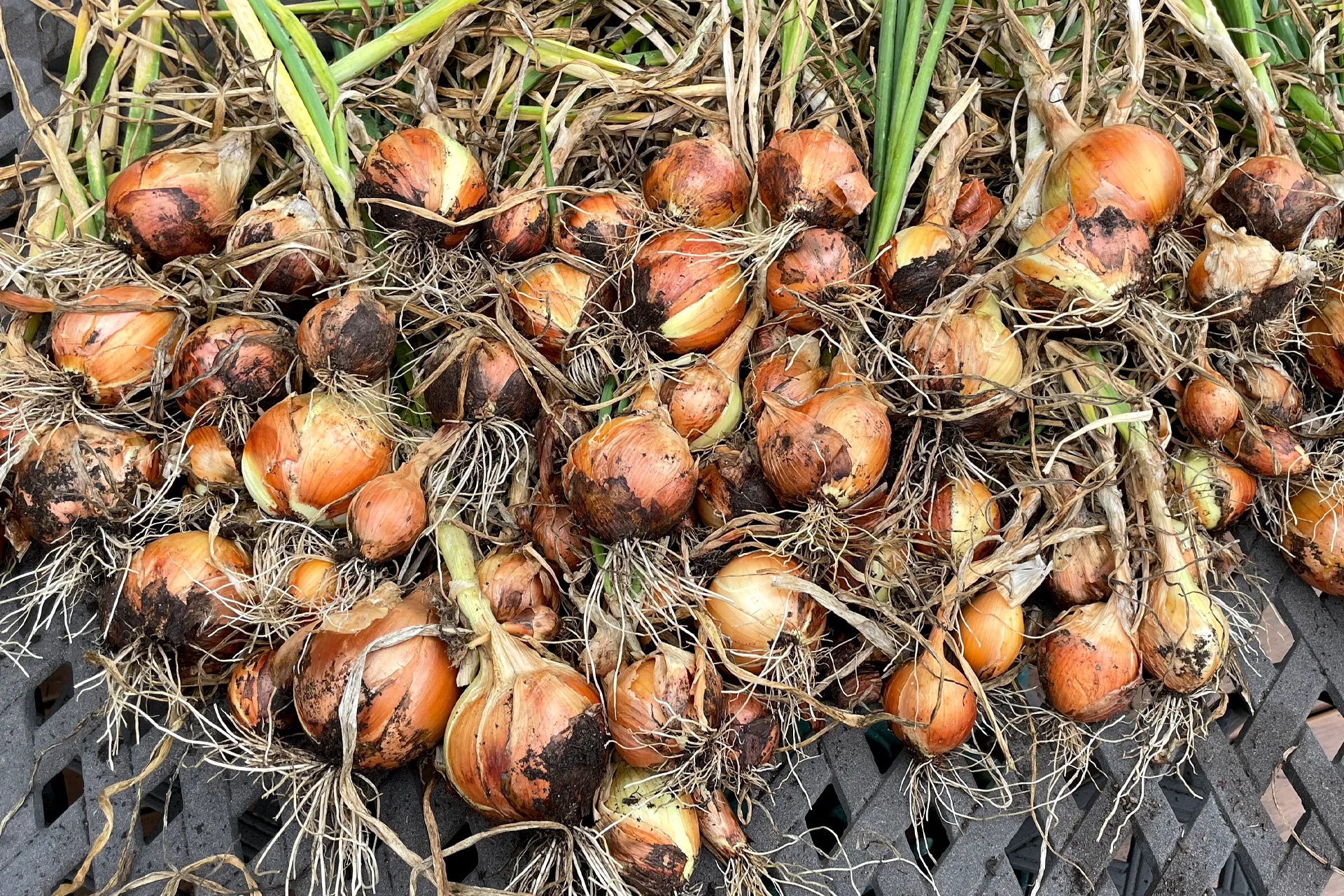This post may contain affiliate links. When you purchase through links on my site, I may earn a commission at no cost to you. See my Privacy Policy for details.
Onions are one of the vegetables I grow in my garden every year. We utilize onions almost daily in the meals that we cook. From French onion soup to Mexican salsa, onions seem to be everywhere. But did you know that growing your onions can save you money and provide you with access to fresh, flavorful produce?
As someone who loves to share their passion for gardening with others, I am excited to show you just how easy it is to grow onions, especially if you’re a beginner. With just a little bit of know-how, you can have a steady supply of delicious, homegrown onions right in your backyard. So, let’s roll up our sleeves and get ready to dig into the basics of growing onions!
Choosing Onion Varieties
Choosing the right type of onion for your garden is an important step in ensuring a successful harvest. Onions can be classified into three categories based on their day-length requirements: short-day, long-day, and day-neutral.
Short-Day Onions
Short-day onions are best suited for regions with mild winters and hot summers, where the day length is 10-12 hours. These onions need less daylight to trigger bulb formation, which makes them ideal for planting in the fall or early winter in the southern United States. Some popular varieties of short-day onions include ‘Red Burgundy’ and ‘Texas Sweet’.
Long-Day Onions
Long-day onions require at least 14-16 hours of daylight to form bulbs and are best suited for cooler climates with longer daylight hours. These onions are typically planted in the spring and harvested in the summer. Some popular varieties of long-day onions include ‘Yellow Globe’ and ‘Sweet Spanish’.
Day-Neutral Onions
Day-neutral onions, as the name suggests, are less sensitive to the length of daylight and can be grown in a wider range of climates. They can be planted in the spring or fall and harvested in the summer or fall. Some popular varieties of day-neutral onions include ‘Walla Walla’ and ‘Candy’.
Choosing Onions for Your Garden
When choosing onion varieties for your garden, consider your location, climate, and preferred planting season. For beginner gardeners, we recommend starting with easy-to-grow varieties such as ‘Sweet Spanish’ or ‘Yellow Globe’, which are forgiving and adaptable to different growing conditions.
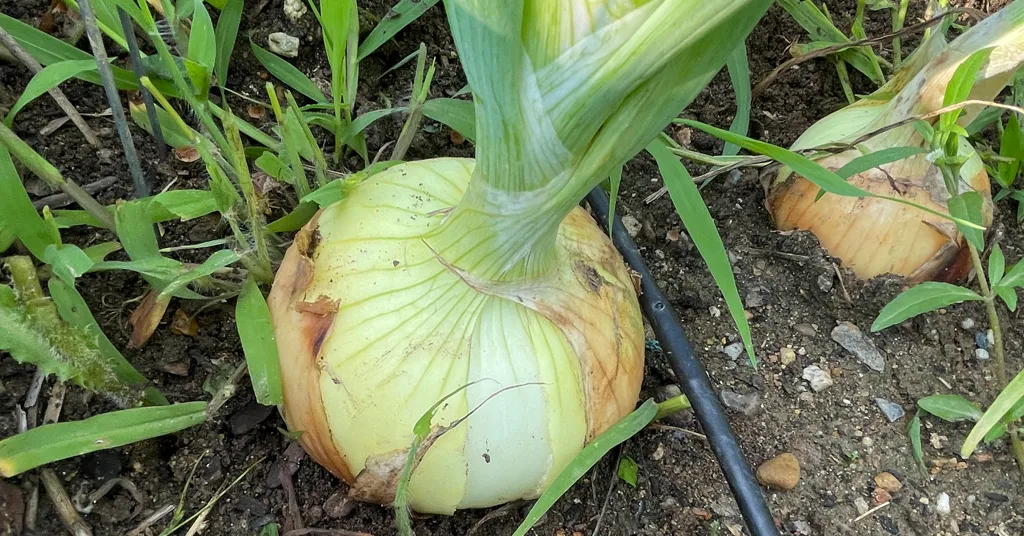
Use the information below to help you decide which onion is best for your garden.
- Location and Climate: The type of onion you choose to grow largely depends on where you live and the climate of your region. If you live in a region with mild winters and hot summers, you should consider planting short-day onions. If you live in a cooler region with longer daylight hours, long-day onions are a better option. Day-neutral onions are suitable for a wider range of climates.
- Planting Season: Depending on your planting season, you may need to choose a specific type of onion that matches the daylight hours during that season. For example, if you want to plant in the fall or early winter, you’ll need to choose a short-day onion variety.
- Taste Preferences: Different varieties of onions have unique flavors and textures. Some varieties are sweeter and milder, while others are more pungent and flavorful. You should choose a variety based on your taste preferences and the types of dishes you plan to cook with the onions.
- Availability: Availability of onion varieties may also play a role in your decision. Some onion varieties may be more readily available at your local nurseries or garden centers. You can also start them from seeds which will open the variety choices for you.
Planting Onions
Now that you’ve chosen the perfect type of onion for your garden, it’s time to get your hands dirty and plant them! The best time to plant onions is usually in early spring or late summer, depending on the type of onion and your region. Onions prefer cooler temperatures and should be planted before the heat of summer sets in.
Before planting, it’s important to prepare the soil. Onions thrive in well-draining soil that is rich in organic matter. If your soil is heavy or compacted, add some compost or well-rotted manure to improve the soil structure and fertility.
When planting onions, you have several options: you can plant onion sets (small bulbs), onion transplants, or onion seeds. Regardless of which method you choose, it’s important to plant them in rows with proper spacing and depth.
Planting Onion Sets
Onion sets are small bulbs that have been started from seed and then harvested before they reach full maturity. They are often used by gardeners as a quick and easy way to start growing onions, as they require less time and effort than starting from seed.
When planting onion sets, it’s important to choose sets that are firm and dry, with no signs of mold or softness. Sets that are larger than a dime but smaller than a quarter are usually the best size for planting. If you’re purchasing sets from a store or nursery, look for sets that have already sprouted green shoots, as these will grow more quickly and reliably than sets without shoots.
To plant onion sets, prepare the soil by loosening it to a depth of about 4-6 inches and mixing in some compost or well-rotted manure. Space the sets 4-6 inches apart in rows that are 12-18 inches apart. Dig a small hole in the soil that is deep enough to cover the set, leaving the tip of the bulb exposed above the soil surface. Gently press the soil around the set to secure it in place.
Onion sets should be planted in soil that has warmed up to at least 50°F (10°C) to promote growth. It’s important to keep the soil consistently moist but not waterlogged during the growing season, as onions are sensitive to both drought and overwatering.
Planting Onion Transplants
Onion transplants are young onion plants that have been started from seed indoors or in a greenhouse and then transplanted into the garden. They are a great option for gardeners who want to get a head start on their onion crop or are growing onions that are not easily available as sets.
To plant onion transplants, prepare the soil by loosening it to a depth of about 4-6 inches and mixing in some compost or well-rotted manure. Space the transplants 4-6 inches apart in rows that are 12-18 inches apart. Make a small hole in the soil that is deep enough to accommodate the root ball of the transplant, leaving the base of the leaves above the soil surface. Gently firm the soil around the transplant to secure it in place.
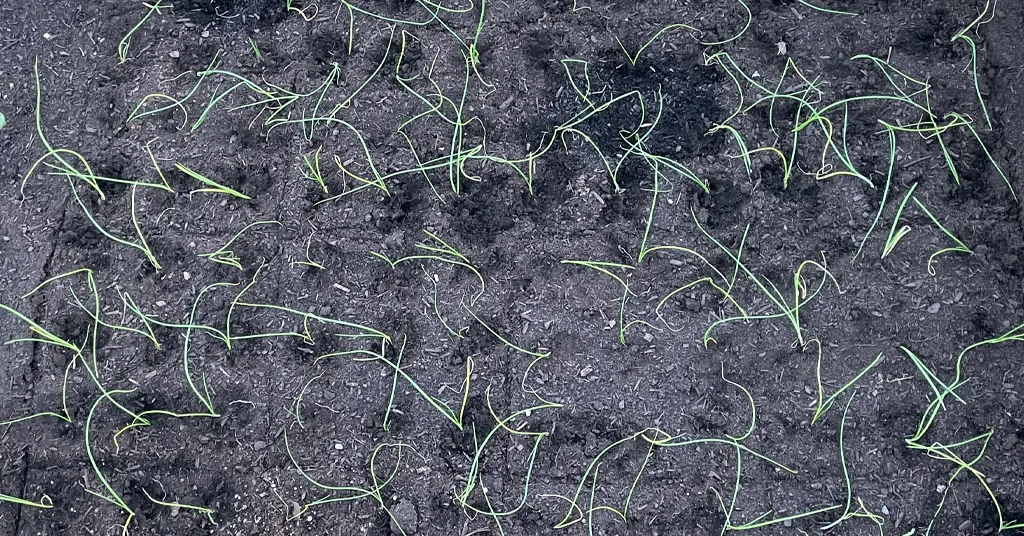
Onion transplants should be planted in soil that has warmed up to at least 50°F (10°C) to promote growth. It’s important to keep the soil consistently moist but not waterlogged during the growing season, as onions are sensitive to both drought and overwatering.
Onion transplants can be more fragile than onion sets, so it’s important to handle them gently when planting. If you’re starting onion transplants from seed, be sure to start them indoors or in a greenhouse about 6-8 weeks before your last expected frost date. This will give them time to grow and establish a strong root system before transplanting.
Planting Onion Seeds
Direct seeding onion seeds is an economical and easy way to grow onions. Seeds can be planted directly in the garden in early spring or in the fall, depending on your location and climate. The ideal soil temperature for onion seed germination is between 55-75°F (13-24°C). You can plant seeds at a depth of 1/4 inch and space them 1-2 inches apart in rows that are 12-18 inches apart. Once the seedlings emerge, thin them to 4-6 inches apart. I use this seeding square to help me space my onion seeds and transplants.
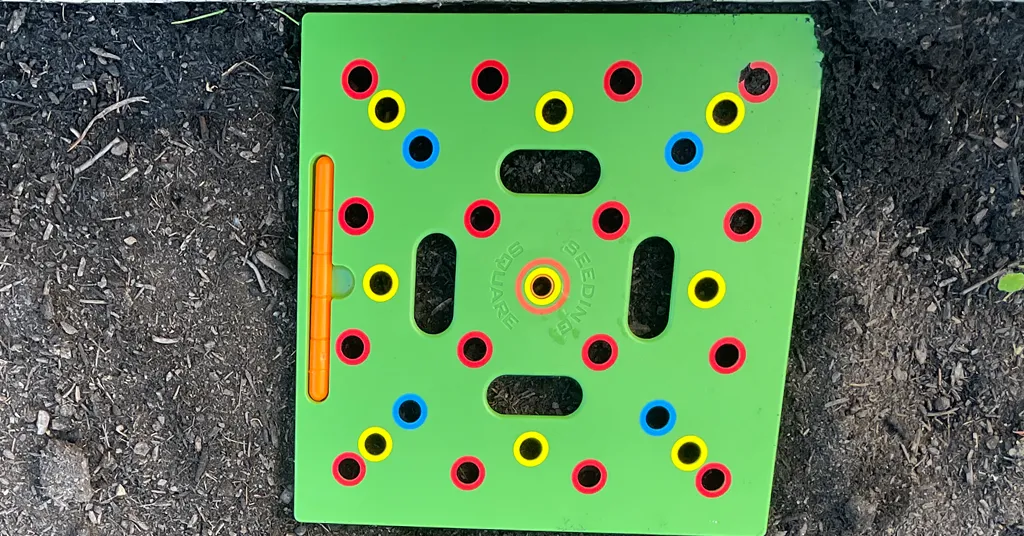
Starting onion seeds indoors is another option that allows you to get a head start on your onion crop. This method is particularly useful for gardeners who live in colder climates or who want to grow onion varieties that are not readily available as sets or transplants.
To start onion seeds indoors, sow the seeds in a tray or pot filled with seed starting mix, and place the tray in a warm, bright location or under grow lights. The ideal temperature for germinating onion seeds is around 68-75°F (20-24°C). Keep the soil moist but not waterlogged, and thin the seedlings to one per cell or transplant to individual pots once they have grown a few inches tall. Once the seedlings have developed a strong root system and are at least 6-8 weeks old, they can be transplanted into the garden.
When planting onion seeds, it’s important to choose a well-draining soil that is rich in organic matter, as onions require plenty of nutrients to grow strong and healthy. Regular fertilization with a balanced fertilizer will also help promote healthy growth. Be sure to keep the soil consistently moist but not waterlogged during the growing season, and avoid over-fertilizing, which can result in soft, poor-quality onions.
Onion seeds may take longer to grow and establish than sets or transplants, but they offer a wide variety of onion types to choose from and can be a cost-effective way to produce a large crop of onions.
Caring for Onions
Watering Onions
Watering onions regularly is essential for their growth and development, but it’s important to avoid overwatering, which can lead to root rot and other issues. Onions should be watered deeply once a week, especially during hot and dry weather conditions. The soil should be moist but not waterlogged. If the soil is still moist from the previous watering, hold off on watering until it dries out a bit.
Fertilizing Onions
Fertilizing onions is also important for their growth and development. Onions require a balanced fertilizer that is rich in nitrogen, phosphorus, and potassium. Fertilize your onions once a month with a balanced fertilizer, following the manufacturer’s instructions for application rates. Be careful not to over-fertilize, as this can result in soft, poor-quality onions.
Weeding Around Onions
Weeding around onions is crucial to prevent competition for nutrients. Weeds can quickly take over and steal the nutrients that your onions need to grow healthy and strong. Regularly remove weeds by hand or with a hoe, being careful not to disturb the onion plants themselves.
Mulching Onions
Mulching onions is another important step in caring for them. The Mulch helps to retain moisture in the soil and suppress weeds, which in turn reduces the need for frequent watering and weeding. Apply a layer of mulch around the onion plants, taking care not to cover the bulbs themselves. Good options for mulch include straw, leaves, or grass clippings.
Harvesting Onions
Knowing when to harvest onions is crucial to getting the best quality and flavor from your crop. Onions are usually ready to harvest when the tops begin to yellow and fall over. This is a sign that the bulbs have stopped growing and are ready to be pulled from the ground. Be sure to harvest your onions before they start to rot or sprout.
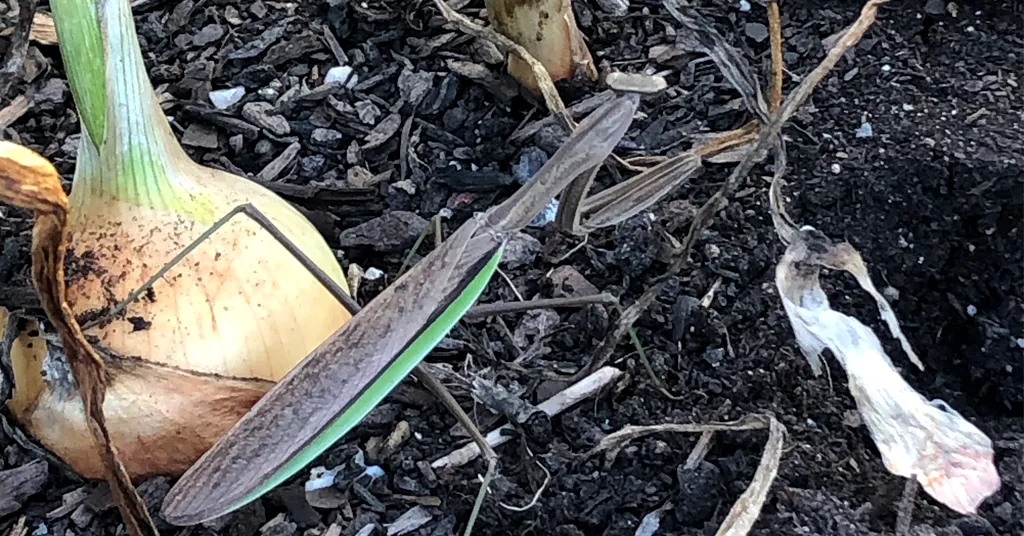
How to Harvest Onions
To harvest onions, carefully loosen the soil around the bulbs with a garden fork or shovel, taking care not to damage the bulbs. Once the bulbs have been loosened, gently pull them from the soil, being careful not to bruise or damage them.
How to Cure Onions
After harvesting, it’s important to cure onions before storing them. This allows the outer layers of the onions to dry and harden, which helps to prevent rot and disease during storage. To cure onions, spread them out in a single layer in a dry, well-ventilated area out of direct sunlight, such as a garage or covered porch. Allow the onions to cure for two to three weeks, until the outer layers are papery and dry.
Storing Onions
Once the onions are cured, they can be stored in a cool, dry place for long-term storage. A good option for storing onions is to hang them in mesh bags or braid the tops together and hang them in a cool, dry place. Another option is to store them in a well-ventilated container, such as a crate or cardboard box, layered with dry straw or newspaper. Be sure to store onions away from direct sunlight and in a place where the temperature stays between 32°F and 40°F.
Let’s Grow Some Onions
Growing onions is a great way to add fresh, flavorful produce to your garden and your meals. With a little bit of planning and care, even beginner gardeners can enjoy a successful onion crop. Whether you choose to grow short-day, long-day, or day-neutral onions, be sure to plant them in well-draining soil, fertilize them properly, and water them regularly without overwatering. Weeding around your onions and mulching them can also help to ensure their success.
When it comes time to harvest, be sure to wait until the tops begin to yellow and fall over, and then carefully dig up your onions and cure them before storing them in a cool, dry place for long-term storage.
If you’re a beginner gardener looking to try your hand at growing vegetables, why not give onions a try? They’re a versatile staple in many cuisines and can add delicious flavor to any dish. With a little bit of patience and care, you can enjoy a bountiful harvest of fresh, flavorful onions from your garden. A great recipe to use some of your onions is in Zucchini Relish.
Looking for more ideas in the growing fruit and vegetables area? Take a look at these additional articles:

